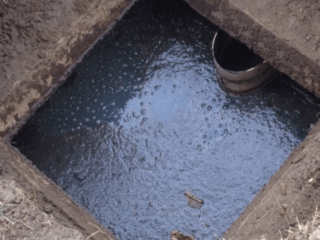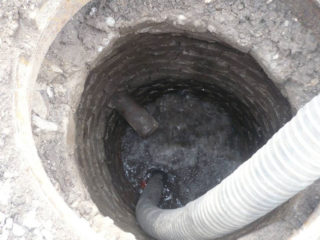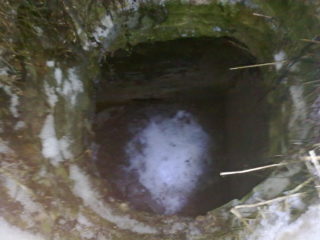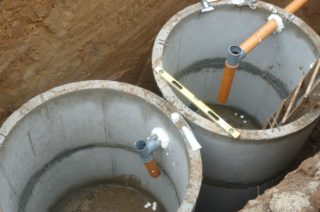A cesspool is an important part of an autonomous sewage system in a private house. Those who live in such a house all year round have to choose a cesspool of an absorbing type, from which sewage can be pumped out no more than once every six months. The main difference between such tanks and conventional ones is gradual self-cleaning. Under such conditions, any additional cleaning methods have to be used much less frequently. But the topic, however, after 1-2 years of operation, a serious problem may appear: the water stops leaving. How to solve this problem yourself, you will learn from the article.
Why doesn't the water go away
Waste falling into the pit gradually seeps into the depths of the earth, but over time the absorbency of the soil decreases, which is why stagnant water is obtained.
The main reasons for the deterioration of soil carrying capacity are as follows:
- Silting up the bottom. Over time, sludge from feces forms at the bottom. It is like a cork that traps liquid so that it cannot seep into the ground;
- The formation of fatty deposits on the walls and bottom, which prevents liquid from seeping into the ground;
- If the problem appeared in winter, then the soil at the bottom of the receiver is frozen and does not allow liquid to pass through;
- Insufficient tank volume. If the size of the pit does not correspond to the amount of waste entering it, this also leads to stagnation of the liquid. Therefore, it is always worthwhile to oversize the tank, or to carry out more careful preliminary measurements.
Ways to solve the problem
When you have found out why the water does not go out through the bottom of the receiver, you can find a suitable way to deal with this problem.
Sludge removal
Sequencing:
- Pump out waste from the cesspool;
- Wash away the sludge from the bottom and walls with a high-pressure water jet;
- Clean the bottom and walls with brushes;
- Flush the tank again and pump out any remaining sludge.
If the sludge could not be cleaned with brushes, you can additionally use these chemicals:
- Formaldehyde products. They are effective, but keep in mind that they have one feature: formaldehyde-based pre-partitions make the soil unsuitable for any plant for at least 7-10 years. Therefore, try not to use such funds unless absolutely necessary;
- Ammonium-based preparations. They also have a small feature: they are effective only at freezing temperatures, so they are used only in summer and spring. But they perfectly eliminate unpleasant odors from the cesspool, and dissolve not only silt, but also fatty deposits on the walls and bottom of the tank;
- Preparations based on a nitrate oxidizer. This is the best option for dealing with poor water flow. Sludge dissolved with such a preparation can be used to fertilize your vegetable garden and garden, as it is separated into an organic component and water.
Elimination of fatty deposits
Fat deposits are formed in the pits faster if they receive a drain not only from the toilet and bathroom, but also from the kitchen. The fat remaining on the dishes, the cleaning agents that contain surfactants, all of this settles not only in the sewer pipes, but also on the walls and bottom of the cesspool. The fat mixes with cold water and becomes a solid layer that prevents liquid from escaping through the soil.
You can deal with this problem in the same way as with silt. It is necessary to pump out the waste with the help of special equipment, and only then clean the bottom and walls from the fat layer using brushes, as well as formaldehyde, ammonium and nitrite oxidizing agents.
Elimination of freezing of the pit in the winter
Before starting work in the pit, it is important to warm up the rest of the communication elements. Start with the pipeline. Insulate each pipe properly and run the electric cable along its entire length, which will give the maximum warming effect.
When the pipes have finished heating up, follow these instructions:
- Pump out the waste from the pit. If they are also frozen, warm it up with a building hair dryer;
- Now heat one end of the metal rod on a fire, and stick it into the layer of silt, deepening the metal into the ground;
- Wind a wire stripped from one side on the end of the rod sticking out of the ground, and connect its plug to the network;
- After the sludge has warmed up, remove it with brushes or chemicals.
This method of cleaning the cesspool is quite effective, but keep in mind that it can take from 12 to 24 hours to warm up the sludge.
Solving the problem with insufficient pit volume
Follow this instruction:
- Calculate the required volume for the new tank and the location where it will be excavated;
- When the new pit is ready, connect it to the first one with an overflow pipe;
- Concrete the bottom of the first tank.
The last point can be disregarded. But if you cover the bottom of the tank with concrete, you end up with a sump that is safer for the environment. Most of the waste will remain in the first pit, while the second will receive mainly liquid.
Preventing the problem
You can very well minimize the risk of water stagnation in the sewer. To do this, you need to observe the following recommendations:
- It is most difficult to clean the pit in winter, so take into account the peculiarities of the local soil before starting the construction of the cesspool. Namely, how deeply the ground freezes during the cold season. If it freezes strongly, it is worth taking care of the insulation of the tank;
- Do not forget that the sewer receiver requires regular pumping of sewage. This should be done at least once every six months, and especially in the case of conservation of the sewage system for the winter;
- During each pumping out of sewage, rinse the walls and bottom of the receiver with a high-pressure water jet. This should be done at least once a year, or at each waste pumping;
- If, when pumping out sewage, you notice that the bottom and walls of the tank have begun to be covered with a layer of silt or grease, use chemical means to remove them;
- In the intervals between pumping out sewage, it is advisable to use preparations based on bacteria. They will speed up the next mechanical cleaning and allow you to delay the pumping process a little. In addition, this procedure will help get rid of the unpleasant odor.













A cesspool, and therefore a cesspool, is that the contents are pumped out of it, and not go into the ground. If it goes into the ground, then this is an ABSORBING pit, the construction of which is prohibited in settlements.
In order for the water to leave the cesspool, it must communicate with the sewer network with forced pumping